当前位置:
X-MOL 学术
›
J. Food Eng.
›
论文详情
Our official English website, www.x-mol.net, welcomes your feedback! (Note: you will need to create a separate account there.)
Changes in lycopene content and quality of tomato juice during thermal processing by a nanofluid heating medium
Journal of Food Engineering ( IF 5.5 ) Pub Date : 2018-08-01 , DOI: 10.1016/j.jfoodeng.2018.02.020 Seyed-Sajjad Jabbari , Seid Mahdi Jafari , Danial Dehnad , Seyed-Ahmad Shahidi
Journal of Food Engineering ( IF 5.5 ) Pub Date : 2018-08-01 , DOI: 10.1016/j.jfoodeng.2018.02.020 Seyed-Sajjad Jabbari , Seid Mahdi Jafari , Danial Dehnad , Seyed-Ahmad Shahidi

|
Abstract The main aim of this study was to evaluate the effects of shortening common thermal processing through nanofluids on quality of tomato juice for the first time. For this purpose, three different temperatures (between 70 and 90 °C), nanoparticle concentrations (between 0 and 4%) and time (between 30 and 90 s) were selected for thermal processing of tomato juice in a shell and tube heat exchanger through central composite design. The findings indicated that while 4% nanoflluid at 30 °C for 30 s led to the best lycopene retention (96%) of tomato juice, hot water treatment (0% nanoparticle concentration) at 90 °C for 90 s resulted in the lowest lycopene retention (67%). The durations required for product to reach a certain temperature were dwindled and treated samples experienced lower color drops when higher nanoparticle concentrations were applied; a*/b* indices at 80 °C were 1.7, 1.8 and 1.9 for 0, 2 and 4% nanoparticles, respectively; indeed, higher nanoparticle concentration, and lower temperature and time led to higher lycopene retention and, as a consequence, higher a*/b* values. The effect of time on pH and acidity indices was not significant while temperature influenced those parameters significantly. Based on the indices considered, if temperature, concentration and time are set at 70 °C, 4% and 30 s, the best responses will be obtained.
中文翻译:

纳米流体加热介质热加工番茄汁番茄红素含量及品质的变化
摘要 本研究的主要目的是首次评估通过纳米流体缩短普通热处理对番茄汁质量的影响。为此,选择三种不同的温度(70 至 90 °C)、纳米颗粒浓度(0 至 4%)和时间(30 至 90 秒)在壳管式换热器中对番茄汁进行热处理。中央复合设计。研究结果表明,虽然 4% 纳米流体在 30 °C 下保持 30 秒导致番茄汁的番茄红素保留率最佳 (96%),但在 90 °C 下热水处理(0% 纳米颗粒浓度)90 秒导致番茄红素最低保留率 (67%)。当应用更高的纳米颗粒浓度时,产品达到特定温度所需的时间缩短了,并且处理过的样品颜色下降更少;对于 0%、2% 和 4% 的纳米粒子,80 °C 下的 a*/b* 指数分别为 1.7、1.8 和 1.9;事实上,更高的纳米颗粒浓度以及更低的温度和时间导致更高的番茄红素保留,因此,更高的 a*/b* 值。时间对 pH 值和酸度指数的影响不显着,而温度对这些参数有显着影响。根据所考虑的指标,如果温度、浓度和时间设置为 70 °C、4% 和 30 s,将获得最佳响应。较低的温度和时间会导致较高的番茄红素保留,从而导致较高的 a*/b* 值。时间对 pH 和酸度指数的影响不显着,而温度对这些参数有显着影响。根据所考虑的指标,如果温度、浓度和时间设置为 70 °C、4% 和 30 s,将获得最佳响应。较低的温度和时间会导致较高的番茄红素保留,从而导致较高的 a*/b* 值。时间对 pH 值和酸度指数的影响不显着,而温度对这些参数有显着影响。根据所考虑的指标,如果温度、浓度和时间设置为 70 °C、4% 和 30 s,将获得最佳响应。
更新日期:2018-08-01
中文翻译:

纳米流体加热介质热加工番茄汁番茄红素含量及品质的变化
摘要 本研究的主要目的是首次评估通过纳米流体缩短普通热处理对番茄汁质量的影响。为此,选择三种不同的温度(70 至 90 °C)、纳米颗粒浓度(0 至 4%)和时间(30 至 90 秒)在壳管式换热器中对番茄汁进行热处理。中央复合设计。研究结果表明,虽然 4% 纳米流体在 30 °C 下保持 30 秒导致番茄汁的番茄红素保留率最佳 (96%),但在 90 °C 下热水处理(0% 纳米颗粒浓度)90 秒导致番茄红素最低保留率 (67%)。当应用更高的纳米颗粒浓度时,产品达到特定温度所需的时间缩短了,并且处理过的样品颜色下降更少;对于 0%、2% 和 4% 的纳米粒子,80 °C 下的 a*/b* 指数分别为 1.7、1.8 和 1.9;事实上,更高的纳米颗粒浓度以及更低的温度和时间导致更高的番茄红素保留,因此,更高的 a*/b* 值。时间对 pH 值和酸度指数的影响不显着,而温度对这些参数有显着影响。根据所考虑的指标,如果温度、浓度和时间设置为 70 °C、4% 和 30 s,将获得最佳响应。较低的温度和时间会导致较高的番茄红素保留,从而导致较高的 a*/b* 值。时间对 pH 和酸度指数的影响不显着,而温度对这些参数有显着影响。根据所考虑的指标,如果温度、浓度和时间设置为 70 °C、4% 和 30 s,将获得最佳响应。较低的温度和时间会导致较高的番茄红素保留,从而导致较高的 a*/b* 值。时间对 pH 值和酸度指数的影响不显着,而温度对这些参数有显着影响。根据所考虑的指标,如果温度、浓度和时间设置为 70 °C、4% 和 30 s,将获得最佳响应。



























 京公网安备 11010802027423号
京公网安备 11010802027423号